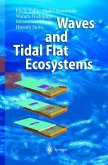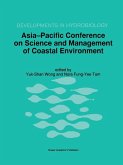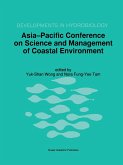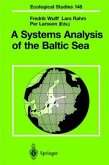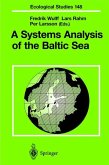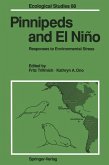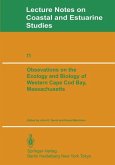Ross Sea Ecology
Italiantartide Expeditions (1987¿1995)
Herausgegeben:Faranda, F.M.; Guglielmo, L.; Ianora, Adrianna
Ross Sea Ecology
Italiantartide Expeditions (1987¿1995)
Herausgegeben:Faranda, F.M.; Guglielmo, L.; Ianora, Adrianna
- Broschiertes Buch
- Merkliste
- Auf die Merkliste
- Bewerten Bewerten
- Teilen
- Produkt teilen
- Produkterinnerung
- Produkterinnerung
The Antarctic represents the last of the world's still unexplored continents. Since 1985, Italy has sent 10 expeditions to this region, three of those have been exclusively devoted to research on the marine ecology of the Ross Sea region. This volume presents a global picture of this research. It includes contributions on water mass characteristics, particulate organic matter and nutrient utilization, and physiological aspects of primary production. Further topics are zooplankton, krill and top predator interactions in relation to physical and biological parameters, ecological features of…mehr
Andere Kunden interessierten sich auch für
![Waves and Tidal Flat Ecosystems Waves and Tidal Flat Ecosystems]() Eiichi BabaWaves and Tidal Flat Ecosystems39,99 €
Eiichi BabaWaves and Tidal Flat Ecosystems39,99 €![Asia-Pacific Conference on Science and Management of Coastal Environment Asia-Pacific Conference on Science and Management of Coastal Environment]() Asia-Pacific Conference on Science and Management of Coastal Environment112,99 €
Asia-Pacific Conference on Science and Management of Coastal Environment112,99 €![Asia-Pacific Conference on Science and Management of Coastal Environment Asia-Pacific Conference on Science and Management of Coastal Environment]() Yuk-Shan WongAsia-Pacific Conference on Science and Management of Coastal Environment115,99 €
Yuk-Shan WongAsia-Pacific Conference on Science and Management of Coastal Environment115,99 €![A Systems Analysis of the Baltic Sea A Systems Analysis of the Baltic Sea]() A Systems Analysis of the Baltic Sea149,99 €
A Systems Analysis of the Baltic Sea149,99 €![A Systems Analysis of the Baltic Sea A Systems Analysis of the Baltic Sea]() Fredrik V. Wulff / Lars A. Rahm / Per Larsson (eds.)A Systems Analysis of the Baltic Sea153,99 €
Fredrik V. Wulff / Lars A. Rahm / Per Larsson (eds.)A Systems Analysis of the Baltic Sea153,99 €![Pinnipeds and El Niño Pinnipeds and El Niño]() Pinnipeds and El Niño77,99 €
Pinnipeds and El Niño77,99 €![Observations on the Ecology and Biology of Western Cape Cod Bay, Massachusetts Observations on the Ecology and Biology of Western Cape Cod Bay, Massachusetts]() Observations on the Ecology and Biology of Western Cape Cod Bay, Massachusetts77,99 €
Observations on the Ecology and Biology of Western Cape Cod Bay, Massachusetts77,99 €-
-
-
The Antarctic represents the last of the world's still unexplored continents. Since 1985, Italy has sent 10 expeditions to this region, three of those have been exclusively devoted to research on the marine ecology of the Ross Sea region. This volume presents a global picture of this research. It includes contributions on water mass characteristics, particulate organic matter and nutrient utilization, and physiological aspects of primary production. Further topics are zooplankton, krill and top predator interactions in relation to physical and biological parameters, ecological features of coastal fish communities and the spatio-temporal variability of benthic biocenoses.
Produktdetails
- Produktdetails
- Verlag: Springer / Springer Berlin Heidelberg / Springer, Berlin
- Artikelnr. des Verlages: 978-3-642-64048-3
- Softcover reprint of the original 1st ed. 2000
- Seitenzahl: 628
- Erscheinungstermin: 27. September 2011
- Englisch
- Abmessung: 235mm x 155mm x 34mm
- Gewicht: 954g
- ISBN-13: 9783642640483
- ISBN-10: 3642640486
- Artikelnr.: 36113689
- Herstellerkennzeichnung
- Springer-Verlag GmbH
- Tiergartenstr. 17
- 69121 Heidelberg
- ProductSafety@springernature.com
- Verlag: Springer / Springer Berlin Heidelberg / Springer, Berlin
- Artikelnr. des Verlages: 978-3-642-64048-3
- Softcover reprint of the original 1st ed. 2000
- Seitenzahl: 628
- Erscheinungstermin: 27. September 2011
- Englisch
- Abmessung: 235mm x 155mm x 34mm
- Gewicht: 954g
- ISBN-13: 9783642640483
- ISBN-10: 3642640486
- Artikelnr.: 36113689
- Herstellerkennzeichnung
- Springer-Verlag GmbH
- Tiergartenstr. 17
- 69121 Heidelberg
- ProductSafety@springernature.com
1 The Italian Oceanographic Cruises in the Ross Sea (1987-95): Strategy, General Considerations and Description of the Sampling Sites.- General Characteristics and Biogeochemical Processes.- 2 Climatic Characterization of the Terra Nova Bay Region.- 3 Oxygen Isotope Characterization of Terra Nova Bay Seawater.- 4 Biogeochemical Processes in the Ross Sea (Antarctica): Present Knowledge and Perspectives.- 5 Some Palaeoecological Remarks on the Ross Sea Shelf, Antarctica.- Water Masses and Circulation Patterns.- 6 Water Masses and Suspended Matter Characteristics of the Western Ross Sea.- 7 Water Mass Characteristics During the ROSSMIZE Cruise (Western Sector of the Ross Sea, November-December 1994).- 8 Large-Scale Circulation Features in the Central and Western Ross Sea (Antarctica).- Nutrients, Particulate Organic Matter, and Microbial Biomass.- 9 Spatial and Temporal Patterns of Nutrient Distributions in the Ross Sea.- 10 Particulate Organic Matter and Nutrient Utilization in the Mixed Layer of the Ross Sea.- 11 Spatial and Temporal Distribution of Particulate Organic Matter in the Ross Sea.- 12 Coupling of Surface Layer Biological Processes and Vertical Flux in the Ross Sea.- 13 Bacteria, Protozoa and Organic Matter Composition in the Sediments of Terra Nova Bay (Ross Sea).- 14 Microbial Biomass and Respiratory Activity Related to the Ice-Melting Layers in the Ross Sea (Antarctica).- Phytoplankton and Primary Production.- 15 Ultraphytoplanktonic Community Structure in the Ross Sea During the Austral Spring 1994.- 16 Picoplankton Abundance and Biomass at Terra Nova Bay (Ross Sea, Antarctica) During the 1989-1990 Austral Summer.- 17 Phytoplankton Size-Fractionated Biomass in the Ross Sea: Spatial and Temporal Variations During the Austral Spring.- 18 PhytoplanktonBiomass Related to Environmental Factors in the Ross Sea.- 19 Spatial and Temporal Distribution of Phytoplankton Assemblages in the Ross Sea.- 20 Ecological and Physiological Aspects of Primary Production in the Ross Sea.- 21 Photosynthetic Parameters, Irradiance, Biooptical Properties, and Production Estimates in the Western Ross Sea.- Zooplankton and Micronekton Distribution.- 22 Distribution of the Main Microzooplankton Taxa in the Ross Sea (Antarctica):Austral Summer 1994.- 23 Copepod Communities in the Pacific Sector of the Southern Ocean in Early Summer.- 24 Planktonic Copepods in Terra Nova Bay (Ross Sea):Distribution and Relationship with Environmental Factors.- 25 Crustacean Decapod Larvae in Terra Nova Bay and in the Ross Sea (Cruises 1987-88 and 1989-90).- 26 Occurrence of Mysidacea (Crustacea) in the Pacific Sector of Antarctica and Distribution of Antarctomysis ohlini in Terra Nova Bay (Western Ross Sea).- 27 Planktonic Ostracoda in the Ross Sea: Their Distribution and Associated Environmental Factors.- 28 Spatial Distribution and Feeding Habits of Larval and Juvenile Pleuragramma Antarcticum in the Western Ross Sea (Antarctica).- 29 A Modelling Approach of the Ross Sea Plankton Ecosystem.- Krill, Nekton and Top Predators.- 30 Characteristic Properties and Dynamic Aspects of Krill Swarms from the Ross Sea.- 31 Spatial and Temporal Distribution of Krill Euphausia superba Biomass in the Ross Sea (1989-1990 and 1994).- 32 The Coastal Fish Fauna of Terra Nova Bay, Ross Sea, Antarctica.- 33 ROSSMIZE Expedition: Distribution and Biomass of Birds and Mammals in the Western Ross Sea.- Benthic Communities.- 34 Morphogroup Analysis of Agglutinated Foraminifers off Terra Nova Bay (Antarctica) (Expedition 1987-1988).- 35 The Macrophytobenthos of Terra NovaBay.- 36 Spatial and Vertical Distribution of Benthic Littoral Communities in Terra Nova Bay.- 37 Shallow-Water Bryozoans and Serpuloideans from the Ross Sea (Terra Nova Bay, Antarctica).- 38 Spatio-Temporal Variability in the Structure of Benthic Populations in a Physically Controlled System off Terra Nova Bay: The Shallow Hard Bottoms.- 39 The Role of Sponges in the Terra Nova Bay Ecosystem.- 40 Benthic Polychaetes off Terra Nova Bay and Ross Sea: Species Composition, Biogeography, and Ecological Role.- 41 The Population Structure and Ecology of the Antarctic Scallop Adamussium colbecki in Terra Nova Bay.- Ecotoxicity Studies.- 42 Bioconcentration of Polychlorinated Biphenyls in the Pelagic Food Chain of the Ross Sea.- 43 Concentration Changes in Cadmium and Lead in Antarctic Coastal Seawater (Ross Sea) During the Austral Summer and Their Relationship with the Evolution of Biological Activity.
1 The Italian Oceanographic Cruises in the Ross Sea (1987-95): Strategy, General Considerations and Description of the Sampling Sites.- General Characteristics and Biogeochemical Processes.- 2 Climatic Characterization of the Terra Nova Bay Region.- 3 Oxygen Isotope Characterization of Terra Nova Bay Seawater.- 4 Biogeochemical Processes in the Ross Sea (Antarctica): Present Knowledge and Perspectives.- 5 Some Palaeoecological Remarks on the Ross Sea Shelf, Antarctica.- Water Masses and Circulation Patterns.- 6 Water Masses and Suspended Matter Characteristics of the Western Ross Sea.- 7 Water Mass Characteristics During the ROSSMIZE Cruise (Western Sector of the Ross Sea, November-December 1994).- 8 Large-Scale Circulation Features in the Central and Western Ross Sea (Antarctica).- Nutrients, Particulate Organic Matter, and Microbial Biomass.- 9 Spatial and Temporal Patterns of Nutrient Distributions in the Ross Sea.- 10 Particulate Organic Matter and Nutrient Utilization in the Mixed Layer of the Ross Sea.- 11 Spatial and Temporal Distribution of Particulate Organic Matter in the Ross Sea.- 12 Coupling of Surface Layer Biological Processes and Vertical Flux in the Ross Sea.- 13 Bacteria, Protozoa and Organic Matter Composition in the Sediments of Terra Nova Bay (Ross Sea).- 14 Microbial Biomass and Respiratory Activity Related to the Ice-Melting Layers in the Ross Sea (Antarctica).- Phytoplankton and Primary Production.- 15 Ultraphytoplanktonic Community Structure in the Ross Sea During the Austral Spring 1994.- 16 Picoplankton Abundance and Biomass at Terra Nova Bay (Ross Sea, Antarctica) During the 1989-1990 Austral Summer.- 17 Phytoplankton Size-Fractionated Biomass in the Ross Sea: Spatial and Temporal Variations During the Austral Spring.- 18 PhytoplanktonBiomass Related to Environmental Factors in the Ross Sea.- 19 Spatial and Temporal Distribution of Phytoplankton Assemblages in the Ross Sea.- 20 Ecological and Physiological Aspects of Primary Production in the Ross Sea.- 21 Photosynthetic Parameters, Irradiance, Biooptical Properties, and Production Estimates in the Western Ross Sea.- Zooplankton and Micronekton Distribution.- 22 Distribution of the Main Microzooplankton Taxa in the Ross Sea (Antarctica):Austral Summer 1994.- 23 Copepod Communities in the Pacific Sector of the Southern Ocean in Early Summer.- 24 Planktonic Copepods in Terra Nova Bay (Ross Sea):Distribution and Relationship with Environmental Factors.- 25 Crustacean Decapod Larvae in Terra Nova Bay and in the Ross Sea (Cruises 1987-88 and 1989-90).- 26 Occurrence of Mysidacea (Crustacea) in the Pacific Sector of Antarctica and Distribution of Antarctomysis ohlini in Terra Nova Bay (Western Ross Sea).- 27 Planktonic Ostracoda in the Ross Sea: Their Distribution and Associated Environmental Factors.- 28 Spatial Distribution and Feeding Habits of Larval and Juvenile Pleuragramma Antarcticum in the Western Ross Sea (Antarctica).- 29 A Modelling Approach of the Ross Sea Plankton Ecosystem.- Krill, Nekton and Top Predators.- 30 Characteristic Properties and Dynamic Aspects of Krill Swarms from the Ross Sea.- 31 Spatial and Temporal Distribution of Krill Euphausia superba Biomass in the Ross Sea (1989-1990 and 1994).- 32 The Coastal Fish Fauna of Terra Nova Bay, Ross Sea, Antarctica.- 33 ROSSMIZE Expedition: Distribution and Biomass of Birds and Mammals in the Western Ross Sea.- Benthic Communities.- 34 Morphogroup Analysis of Agglutinated Foraminifers off Terra Nova Bay (Antarctica) (Expedition 1987-1988).- 35 The Macrophytobenthos of Terra NovaBay.- 36 Spatial and Vertical Distribution of Benthic Littoral Communities in Terra Nova Bay.- 37 Shallow-Water Bryozoans and Serpuloideans from the Ross Sea (Terra Nova Bay, Antarctica).- 38 Spatio-Temporal Variability in the Structure of Benthic Populations in a Physically Controlled System off Terra Nova Bay: The Shallow Hard Bottoms.- 39 The Role of Sponges in the Terra Nova Bay Ecosystem.- 40 Benthic Polychaetes off Terra Nova Bay and Ross Sea: Species Composition, Biogeography, and Ecological Role.- 41 The Population Structure and Ecology of the Antarctic Scallop Adamussium colbecki in Terra Nova Bay.- Ecotoxicity Studies.- 42 Bioconcentration of Polychlorinated Biphenyls in the Pelagic Food Chain of the Ross Sea.- 43 Concentration Changes in Cadmium and Lead in Antarctic Coastal Seawater (Ross Sea) During the Austral Summer and Their Relationship with the Evolution of Biological Activity.


